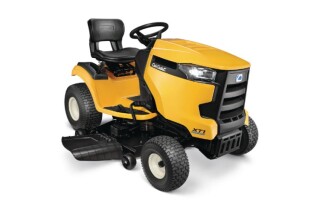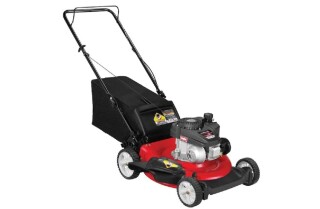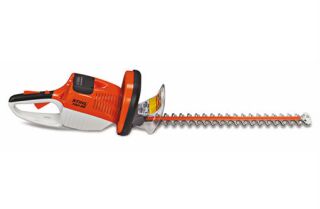Since the beginning of gasoline powered appliances, lawn equipment has come to the fore as the largest users of small engines. This revolution began with the first gasoline powered lawn mowers back in 1914. 4 cycle or 4 stroke engines were the original power plant of choice. But as more and more people began to move out into the suburbs (where lawn and garden care became more prominent) 2 cycle engines began to make an appearance. These engines were smaller, lighter and more powerful than their 4 stroke cousins, so they could be more readily adapted to hand-held appliances like brush cutters,trimmers, blowers and weed eaters.
Electric motors were in use too, but in far less limited quantities. Although electric motors offered nearly equal power to a gas engine, they were not widely adopted since they always needed to be tethered to a power outlet. Battery powered motors were initially impractical because they offered far less power, and battery technology was only capable of delivering running time in the minutes. Therefore, battery operated lawn equipment was not a viable type of power source until the newest Lithium-Ion batteries made an appearance in the early 2000's.
Gasoline 2-Cycle
This is the most common type of engine in use for smaller lawn equipment like leaf blowers and weed eaters among others. Modern versions put out the most power to the size ratio of the engine, yet they are light enough to be easily carried around. They must run on a gas and oil fuel mixture, and if not precisely measured, the engine will not run correctly. Modern synthetic oils have attempted to correct this problem with a one-oil-ratio fits all. You can literally pour 1.5 ounces of synthetic 2-cycle oil into 1 gallon of gasoline, and the mixture will be correct for virtually any 2-cycle engine requirements.
2-cycle engines, although powerful, spew oily smoke every time they’re running because of the engine design. In fact, 2-cycle engines have been banned in many regions due to air pollution concerns. They are also not very durable which has to do as much with the fuel mixture as with the high RPM's that they produce. Again, modern 2-cycle synthetic oil does eliminate much of the oil smoke and adds to the longevity of the engine, but it’s more expensive to use than conventional 2-cycle oil.
Contemporary 2-cycle engines have been engineered to be more tolerant of an incorrect gas and oil mix, and they are stronger and are less problematic than 2-cycle engines of old. Yet, they can still be a hassle to use by being difficult to start, and because of the oil in the gas, they have a tendency to foul spark plugs regularly. If left without running for a season while not having been drained (or if a stabilizer hasn’t been added to the fuel) the carburetor can plug up and render the engine useless.
Gasoline 4-Cycle
These are the newest small engines made for hand-held lawn equipment, and modern metals and materials have finally made a 4-cycle competitive, in both size and weight, with a 2-cycle engine.
In years past, a 4 cycle engine that put out the power of a 2-cycle would have been twice as heavy and almost twice as big, a difficult sell for the average homeowner. However, it has now gotten to the point that 4-cycle engines are nearly the equal of 2-cycle engines in both power output and light weight, and as such, have become a viable hand-held alternative.
The biggest selling point is that they only take straight gasoline for fuel, since like all 4-cycle engines, the oil is contained separately in the crankcase and used for lubrication. That means there is never any mixing of gas and oil for fuel. Also, 4-cycles run at a lower RPM, which means less wear and tear on the pistons, rings and seals. This makes them inherently last longer. They also rarely foul the spark plug, they don't smoke unless the fuel mixture is too rich, which can be adjusted, they are more fuel efficient, and virtually every one of them are certified for use in all 50 states.
Even though they’re a bit more expensive in the short run, their inherent durability and efficiency means they’ll last longer, perform better than the average 2-cycle powered lawn appliance, and cost you less to use in the long run.
Electric Motors
Plug-In
Plug-in motors rival the fossil fueled motors for power, and many of these actually have a comparable horsepower rating with much higher torque ratings. These are the least expensive electric lawn appliances available, and they will give a very good account of themselves in all aspects of power and performance. However, you will always be tethered to an outlet with a long cord, and virtually every electric power plant is only recommended to be used with a 100 foot cord or less.
What you give up in versatility you gain with a no hassle machine. They are literally plug-in and go, with never any worry about gasoline, oil or mixing, and they are considered maintenance free. Nearly anyone can use them, and they are perfect for city or suburban dwellings that only have a limited amount of land. Plus, when compared to gasoline powered models, they only cost pennies on the dollar to use.
Battery Operated
These are the most expensive lawn appliances available, and although they are a bit down on power to both the plug-in and gasoline powered types, no appliance is as reliable or as easy to use, plus, they are the most environmentally friendly units made.
Battery powered engines are just as versatile as gasoline varieties. They can be taken anywhere at any time, and just like plug-in models, they activate at the touch of a switch. The problem with these models has always been the battery. Early units would last a few minutes before the battery was exhausted, and except for the smallest of jobs, battery operated models were almost impractical to use.
Modern battery powered lawn appliances have come a long way, and the newest Lithium-Ion batteries will literally last as long as a tank of gas. In virtually all cases, the higher the voltage of the battery, the longer the run time on the piece of equipment. However, extra batteries can be purchased to double or triple run time as needed.









